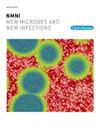靶向下一代测序提高了医疗保健相关感染监测的准确性和快速检测:揭示icu中的多药耐药定植
IF 5.4
Q2 INFECTIOUS DISEASES
引用次数: 0
摘要
目的本研究旨在评估靶向下一代测序(tNGS)在医院相关感染(HAIs)病原体检测中的潜在优势。方法对所有EICU医务人员和体检中心医务人员进行问卷调查。收集符合所有纳入标准而不符合排除标准的医务人员的鼻咽标本。EICU医务人员各提供2份样本,体检中心医务人员各提供1份样本。对EICU医务人员进行两份鼻咽拭子中的一份进行tNGS检测,另一份进行细菌培养检测。对于PEC工作人员,他们的鼻咽拭子进行了tNGS测试。随机抽取急诊icu医护人员使用的6副眼镜和6个键盘,用无菌拭子擦拭表面进行tNGS检测。结果在EICU组23份鼻咽拭子样本中,tNGS在19 h内检出29例14种微生物,细菌培养在19 h内检出4例2种微生物,2例阳性,69 h内检出2例阳性。从EICU组23名成员和PEC组15名成员的鼻咽拭子中共检出42份14种不同微生物。其中,EICU工作人员检出14种不同微生物29例(69%),平均每人检出1.3种微生物;PEC工作人员检出6种不同微生物13例(28%),平均每人检出0.9种微生物。最常见的定植细菌包括金黄色葡萄球菌、鲍曼不动杆菌和克雷伯氏菌。与细菌培养相比,tNGS在监测HAIs方面具有优势,包括可检测微生物范围广、结果灵敏度高、阳性结果报告时间短。定植在EICU的细菌携带更多的抗生素抗性基因。结论ngs在卫生保健相关感染监测中优于常规培养,具有更高的灵敏度和更快的病原体识别速度。同时,tNGS揭示了多药耐药(MDR)病原体(如鲍曼不动杆菌,MRSA)在EICU环境中的广泛定植,突出了其在监测复杂抗菌素耐药模式方面的应用。本文章由计算机程序翻译,如有差异,请以英文原文为准。
Targeted next-generation sequencing enhances precision and rapid detection in healthcare-associated infection Surveillance: Unveiling multidrug-resistant colonization in ICUs
Objectives
This study aims to evaluate the potential advantages of targeted next-generation sequencing (tNGS) over conventional bacterial culture methods for pathogen detection in hospital-associated infections (HAIs).
Methods
All EICU medical staff and all medical staff from the Physical Examination Centre completed a questionnaire. Nasopharyngeal specimens were collected from medical staff who met all of the inclusion criteria and none of the exclusion criteria. EICU medical staff provided 2 samples each, while Physical Examination Centre staff provided 1 sample each. For EICU medical staff, one of their two nasopharyngeal swabs was subjected to tNGS testing, and the other to bacterial culture testing. For the PEC staff, their nasopharyngeal swabs were subjected to tNGS testing. Additionally, six pairs of spectacles and six keyboards used by EICU medical staff were randomly selected, and the surfaces were swabbed with sterile swabs for tNGS testing.
Results
In 23 nasal swab samples from EICU group, tNGS detected 14 species of microorganism in 29 instances within 19 h. Bacterial culture detected 2 species of microorganism in 4 instances, 2 positive samples within 19 h and confirmed another 2 positive samples within 69 h. A total of 42 samples with 14 different microorganism species were collected from the nasopharyngeal swabs of 23 EICU members and 15 PEC members. Among them, 29 cases (69 %) of 14 different microorganisms were detected in EICU staff, with an average of 1.3 microorganism species detected per person, while 13 cases (28 %) of 6 different microorganisms were detected in PEC staff, with an average of 0.9 microorganism species detected per person. The most common colonizing bacteria included Staphylococcus aureus, Acinetobacter baumannii, and Klebsiella spp. Compared to bacterial culture, tNGS offers advantages in monitoring HAIs, including a broad range of detectable microorganisms, high sensitivity of results, and shorter reporting time for positive results. Bacteria colonizing the EICU carry more antibiotic resistance genes.
Conclusions
tNGS outperforms conventional culture in healthcare-associated infection surveillance, with higher sensitivity and accelerated pathogen identification. Simultaneously, tNGS revealed extensive colonization of multidrug-resistant (MDR) pathogens (e.g., Acinetobacter baumannii, MRSA) in EICU environments, highlighting its utility in monitoring complex antimicrobial resistance patterns.
求助全文
通过发布文献求助,成功后即可免费获取论文全文。
去求助
来源期刊

New Microbes and New Infections
Medicine-Infectious Diseases
CiteScore
10.00
自引率
2.50%
发文量
91
审稿时长
114 days
 求助内容:
求助内容: 应助结果提醒方式:
应助结果提醒方式:


